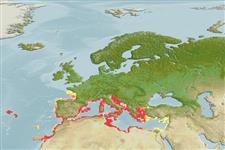Common names from other countries
Classification / Names / Names
Nomi Comuni | Sinonimi | Catalog of Fishes (gen., sp.) | ITIS | CoL | WoRMS
Environment: milieu / climate zone / depth range / distribution range
Ecologia
; distribuzione batimetrica 1 - 100 m (Ref. 105991). Subtropical; 49°N - 27°N, 19°W - 36°E
Eastern Atlantic and Mediterranean: from France to Spain, Portugal, Morocco, Madeira Island and Canary Islands, including the Mediterranean.
Length at first maturity / Size / Peso / Age
Maturity: Lm ? range ? - ? cm Max length : 8.3 cm SHL maschio/sesso non determinato; (Ref. 123052); Peso massimo pubblicato: 58.20 g (Ref. 123052)
Intertidal to a depth of 80 m. Found in a lagoon (Ref. 105976). Also found offshore (Ref. 122927). Inhabits rocky, sandy-mud and mud substrata (Ref. 105992). Also found on seagrass (Ref. 85545). Opportunistic feeder, exhibiting both carnivory and scavenging. Feeds on a variety of bivalves, including gastropods, barnacles, tunicates, bryozoans, carrion and its conspecifics. Employs drilling and chipping patterns on certain bivalves (Ref. 106099).
Life cycle and mating behavior
Maturità | Riproduzione | Deposizione | Uova | Fecundity | Larve
This species is a non-broadcast spawner. Life cycle does not include trocophore stage. Also Ref. 833.
Templado, J. and R. Villanueva. 2010. (Ref. 85339)
IUCN Red List Status (Ref. 130435)
CITES status (Ref. 108899)
Not Evaluated
Not Evaluated
Threat to humans
Harmless
Human uses
Pesca: commerciale
| FishSource |
Strumenti
Informazioni ulteriori
Age/SizeAccrescimentoLength-weightLength-lengthMorfologiaLarveAbbondanza
Fonti Internet
Estimates based on models
Preferred temperature
(Ref.
115969): 14.5 - 21.5, mean 18.7 (based on 202 cells).
